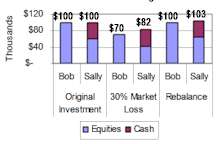|
Diversifying
reduces risk and increases return
For
this simple illustration we will use 2
uncorrelated asset classes: US Equities
and Money Markets.
-
Bob
has 100% of his $100,000
invested in a US equities.
-
Sally
has taken a 60/40 risk averse
approach putting $60,000 in US
equities and $40,000 in a money
market fund.
In
a sudden and sharp downturn, equities fall
30%.
-
Bob's
portfolio would lose 30% of it's
value, and
-
Sally's
portfolio would lose only 18% of its
value [actually less, because she
would also be earning interest on
her money market funds].
While
stocks are down, Sally is able to
rebalance her portfolio.
-
Sally
re-establishes her 60/40 ratio by
moving $7,200 from her money market
into US equities [buying low].
-
When
the stock market returns to its
original value, Bob would be back at
$100,000, while Sally would have
over $103,000 [actually more, because
she would continue earning interest
on her money market funds, and she
would own more US equity shares that
would earn additional dividends].
Summary
of the benefits of diversification.
-
Lessens
losses in a down market—reducing
pressures that cause mistakes
[selling when the market is down].
-
Enables
you to buy low and sell high—automatically.
-
Increase
earnings with money market
dividends, and dividends from
additional shares purchased during a
down market.
-
Losing
less in down markets.
-
Earning
more in flat markets.
-
Using
short and mid-term market
fluctuations to produce higher
returns in the long-term.
|
Benefits
of Diversification
and Rebalancing

|


|
|
 
|

|
|